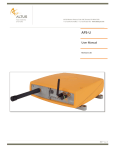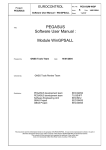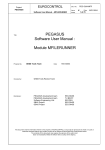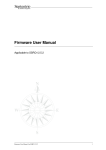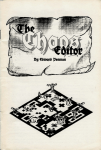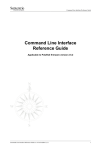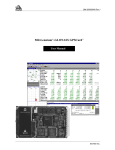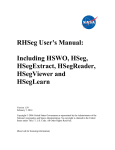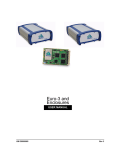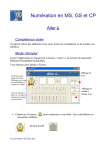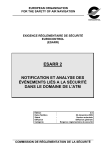Download PEGASUS Software User Manual : Module CONVERTOR
Transcript
Project: PEGASUS EUROCONTROL Doc. No.: Issue: Software User Manual – CONVERTOR Title: Sheet PEG-SUM-CNV K Date: 14/01/2004 1 of 27 PEGASUS Software User Manual : Module CONVERTOR Prepared by: GNSS Tools Team Date: 14/01/2004 Checked by: GNSS Tools Review Team Distribution: PEGASUS development team PEGASUS development team Software Engineering Unit SBAS Project GBAS Project EEC/GNSS TU BS/IFF EEC/SEU EEC/GNSS EEC/GNSS This document and the information therein is the property of EUROCONTROL. It must not be reproduced in whole or in part or otherwise disclosed without prior written consent of the Director EUROCONTROL Experimental Centre. The contents of this document only express the opinions of the author and does not necessarily reflect the official views or policy of the Agency. EUROCONTROL Project: PEGASUS Doc. No.: Issue: Software User Manual – CONVERTOR Sheet PEG-SUM-CNV K Date: 14/01/2004 2 of 27 DOCUMENT IDENTIFICATION SHEET DOCUMENT DESCRIPTION Document Title PEGASUS Software User Manual - Module CONVERTOR EDITION : K EDITION DATE : Abstract 14/01/2004 Software User Manual for the data conversion module of the PEGASUS data processing and analysis system. GNSS GLONASS GPS ESTB CONTACT PERSON: Keywords data conversion SBAS software user manual ephemeris satellite navigation EGNOS PEGASUS EATMP GNSS Programme TEL: + GBAS multipath receiver 33-1-6988-7571 UNIT: GNSS Tools DOCUMENT STATUS STATUS Working Draft Draft Proposed Issue Released Issue CATEGORY Executive Task Specialist Task Lower Layer Task ELECTRONIC BACKUP INTERNAL REFERENCE NAME : SUM_CNV.DOC CLASSIFICATION General Public EATMP Restricted EUROCONTROL Project: PEGASUS Doc. No.: Issue: Software User Manual – CONVERTOR Sheet PEG-SUM-CNV K Date: 14/01/2004 3 of 27 CHANGE RECORD Issue Date Chapter Description of Changes 0-F All Previous Issues for Software Versions 0.9 to 1.2 “PEGASUS Software User Manual, PEG-SUM-01, Issue F” G 17/01/2003 All Issue associated with PEGASUS*Plus 2.0 Restructuring of Document due to a significant change in the Architecture of the Software and Modularisation MEDLL conversion capability H 09/04/2003 3 Issue reviewed for PEGASUS*Plus 2.1 I 17/06/2003 All Minor editorial changes J 24.06.2003 3 Updated for version 3.1 K 14.01.2004 3.3 3.4.1 1.5 Update for version 3.2 (RINEX Format and automatic receiver) Project: PEGASUS EUROCONTROL Doc. No.: Issue: Software User Manual – CONVERTOR Sheet PEG-SUM-CNV K Date: 14/01/2004 4 of 27 TABLE OF CONTENTS 1 INTRODUCTION..................................................................................................................6 1.1 Purpose of this document .............................................................................................6 1.2 Definitions, Acronyms and Abbreviations......................................................................6 1.3 References....................................................................................................................7 1.4 Overview .......................................................................................................................8 1.5 Receivers Implemented ................................................................................................9 2 INSTALLATION AND SYSTEM REQUIREMENTS...........................................................10 2.1 Installation ...................................................................................................................10 2.2 System Requirements.................................................................................................10 3 CONVERTOR ....................................................................................................................11 3.1 Introduction .................................................................................................................11 3.2 Managing a conversion ...............................................................................................11 3.2.1 Starting the CONVERTOR .....................................................................................11 3.2.2 Starting a sequence ...............................................................................................14 3.3 Data Input ...................................................................................................................14 3.4 Use of Software...........................................................................................................15 3.4.1 The Control Area ....................................................................................................15 3.4.2 The Status Area .....................................................................................................18 3.4.3 The Display Area....................................................................................................19 3.5 Data Output.................................................................................................................20 APPENDIX A: ERRORS, WARNINGS AND RECOVERY PROCEDURES ............................22 APPENDIX B: FORMAT AND DESCRIPTION OF THE INI-FILES.........................................25 Appendix B.1 File Contents......................................................................................................25 Appendix B.2 Sample File ........................................................................................................26 Project: PEGASUS EUROCONTROL Doc. No.: Issue: Software User Manual – CONVERTOR Sheet PEG-SUM-CNV K Date: 14/01/2004 5 of 27 TABLES OF FIGURES Figure 1: Screenshot of the CONVERTOR Icon ...................................................................11 Figure 2: Screenshot of the CONVERTOR main interface....................................................12 Figure 3: Screenshot of the Error Message “Missing INI-file”................................................13 Figure 4: Screenshot of the Error Message “Erroneous Parameter Setting” .........................13 Figure 5: Screenshot of the control section ...........................................................................15 Figure 6: Screenshot of the options registry card ..................................................................16 Figure 7: Screenshot of details for the PRN options..............................................................16 Figure 8: Screenshot of the status section ............................................................................18 Figure 9: Screenshot of the display registry card ..................................................................20 Project: PEGASUS EUROCONTROL Doc. No.: Issue: Software User Manual – CONVERTOR Sheet PEG-SUM-CNV K Date: 14/01/2004 6 of 27 1 Introduction 1.1 Purpose of this document This document is intended to serve as a handbook for the users of the PEGASUS module CONVERTOR. As the purpose of PEGASUS is mainly based on the processing of data collected in-flight and on-ground with satellite navigation systems, especially the EGNOS Satellite Test bed (ESTB), a background in the fields of satellite navigation and air traffic management is also necessary for every user working with the PEGASUS software. The tools developed allow experimental use of satellite navigation and augmentation systems, notably the European Satellite Test bed, ranging and (wide-area)-differential ranging processing of GPS and ESTB and combinations. The purpose of the document is to describe the use of the software program CONVERTOR used either as module in PEGASUS or as a standalone program. It should be noted that the current PEGASUS module CONVERTOR is intended for use primarily with the ESTB Signal-In-Space V1.2, which is based on a combination of the specifications [7] and [8]. The PEGASUS Technical Notes [4] illustrate the currently existing specifications which are applied to the ESTB SIS V1.2. The relevant parts of the ESTB SIS V1.2 are as well described in [9]. In order to use the prototypes correctly, it is recommended that the user should read the Interface Control Document ICD [1] (which describes an important part of the data formats used) and the Technical Notes TN [4] (which describes the algorithmic implementation). It will be helpful to read the ESTB User Interface documentation [10], although this document describes the ESTB Signal-In-Space V1.0, which is based in the specification contained in [6]. 1.2 Definitions, Acronyms and Abbreviations AAIM ASCII Aircraft Autonomous Integrity Monitoring American Standard Code for Information Interchange Doc. No. DD Document Number Design Document EEC EGNOS ESTB EUROCONTROL Experimental Centre European Geostationary Navigation Overlay System EGNOS Satellite Test Bed ICD Interface Control Document GBAS GLONASS GNSS GPS Ground Based Augmentation System Global Navigation Satellite System by Russia Global Navigation Satellite System Global Positioning System MEDLL Multipath Estimation Delay Locked Loop EUROCONTROL Project: PEGASUS Issue: Software User Manual – CONVERTOR PEG-SUM-CNV Doc. No.: K Sheet Date: 14/01/2004 7 of 27 MT Message Type PEG PEGASUS PRN PEGASUS Prototype EGNOS GBAS Analysis System Using SAPPHIRE Pseudo-Random Noise – Satellite Identifier RAIM RINEX RTCA Receiver Autonomous Integrity Monitoring Receiver Independent Navigation Exchange Radio Technical Commission for Aeronautics SAPPHIRE SARPS SBAS SIS SUM Satellite and Aircraft Database Project for System Integrity Research Standards and Recommended Practices Satellite Based Augmentation Systems Signal In Space Software User Manual TBD TN to be determined / defined Technical Notes URD UTC User Requirements Document Universal Time Co-ordinated WAAS WGS84 Wide Area Augmentation System World Geodetic System 1984 1.3 References [1] PEGASUS Interface Control Document, Doc. No. PEG-ICD-01 [2] PEGASUS User Requirement Document, Doc. No. PEG-URD-01 [3] PEGASUS*PLUS User Requirement Document1, Doc. No. PEG+-URD-01 [4] PEGASUS Technical Notes, Doc. No. PEG+-TN-SBAS [5] PEGASUS Software User Manual Frame, PEG-SUM-01 [6] RTCA: Minimal Operational Performance Standards for GPS/WAAS Airborne Equipment. Doc. No. Do 229, June 1996, Including Change 1, July 1997 [7] RTCA: Minimal Operational Performance Standards for GPS/WAAS Airborne Equipment. Doc. No. Do 229 A, June 1998 [8] RTCA: Minimal Operational Performance Standards for GPS/WAAS Airborne Equipment. Doc. No. Do 229 B, October 1999 [9] ESTB-CPF Improvements and Corrective Maintenance ESTB-UPG, Analysis of compliance with MOPS DO-229B, Doc. No. GMV-ESTB_UPG-TN-001/01 1 The PEGASUS*Plus project established an extension to the original PEGASUS project that decode, process and evaluate the GNSS / SBAS data. Recent developments have integrated all these modules into a PEGASUS frame and the necessary documentation has been modified accordingly – except for the URD where it has been decided not to generate a new issue. Project: PEGASUS EUROCONTROL Doc. No.: Issue: Software User Manual – CONVERTOR Sheet PEG-SUM-CNV K Date: 14/01/2004 8 of 27 [10] ESTB SIS User Interface Description, ESA, Doc.-No. : E-TN-ITF-E31-0008-ESA, issue 0, revision 1, 20-06-00 [11] NAVSTAR Global Positioning System, System Characteristics, NATO-MASSTANAG 4294, May 1995 [12] OEM4 User Manual - Volume 2 Command and Log Reference, NovAtel Inc., Pub-No OM-20000047 Revision Level 7, 2001/06/21 [13] Millennium GPSCard Software Version 4.50, NovAtel Inc., Doc.-No.: OM2000000041, Revision Level 1, 1998 [14] Aquarius 5000 Series User’s Manual, Dassault-Sercel Navigation Products DSNP, Doc.-No.: 0311374 Rev B, Jan 1999 [15] ConfPack Configuration Software for DSNP GNSS/GPS Receivers – Reference Manual, Dassault-Sercel Navigation Products DSNP, Doc.-No.: 0311373 Rev B, Jan 1999 [16] Septentrio PolaRx evaluation kit description V1.01, July 2001 [17] Portable MEDLL Receiver, Installation and Operation Manual, NovAtel OM-20000065 Rev. 0C, 26.09.2001 [18] SAPPHIRE I Integrity Monitoring, Technical Note, 1996 [19] SAPPHIRE II Integrity Monitoring, Technical Note, 1998 [20] SAPPHIRE DUAU User Manual, Doc. No. DUAU-TN-2472-002, Issue J, May 1999 [21] PEGASUS Receiver Integration Description Document, Doc.-No. PEG-RID-01 1.4 Overview The PEGASUS frame and modules are based on several main software programs allowing the user to decode GNSS data that are then used to perform a GNSS navigation solution. The user is then able to perform further calculation described in the complete set of PEGASUS Software User Manuals (which are contained in the Software User Manual for the PEGASUS FRAME programme [5]). This document contains the Software User Manual for the PEGASUS module CONVERTOR. This section contains a short introduction to the PEGASUS approach of GPS/SBAS data processing. In chapter 2 of this document, a short description for the installation and de-installation of the CONVERTOR module is given when they are used as stand alone programs. Chapter 3 will describe the use of the CONVERTOR software. The Appendix A provides a list of possible error warnings and the associated recovery procedures for the CONVERTOR module and the Appendix B contains a description of the initialisation file which is associated with the CONVERTOR module. EUROCONTROL Project: PEGASUS Doc. No.: Issue: Software User Manual – CONVERTOR Sheet PEG-SUM-CNV K Date: 14/01/2004 9 of 27 1.5 Receivers Implemented Data recorded from the following receivers and receiver families can be used: receiver used to collect data name of “receiver” implemented NovAtel GPS/WAAS Millenium (OEM3) NovAtel GPS/WAAS NovAtel TestBed Receiver (OEM3/5) NovAtel OEM 2 Receivers (GPS only) DSNP Aquarius 5000 DSNP Aquarius 5000 DSNP Aquarius 5001 Septentrio PolaRx-1 Septentrio PolaRx-1 NovAtel OEM-4 NovAtel OEM-4 NovAtel MEDLL Receiver NovAtel MEDLL RINEX 2.1 Format Table 1: Receivers Implemented in PEGASUS Due to the modular architecture of the CONVERTOR program, software developers are able now to develop their own dynamic link libraries that interface with the existing CONVERTOR module and thus implement conversion routines for particular receivers on a “as-needed basis”. Instructions for the design and development of such a DLL can be found in the Receiver Integration Document [21]. Project: PEGASUS EUROCONTROL Doc. No.: Issue: Software User Manual – CONVERTOR Sheet PEG-SUM-CNV K Date: 14/01/2004 10 of 27 2 Installation and System Requirements 2.1 Installation The CONVERTOR program does not need to be installed. In order to use the CONVERTOR, the user has just to copy the delivered files (i.e. the executable and the help file) into the selected directory. In order to preserve the user-selected options, the CONVERTOR program writes an INI-file into the directory in which the executable is located. The provided INI-file in the delivery can be copied into the appropriate directory. However, if no such INI-file is found when the CONVERTOR is run, this file is created. In order to completely de-install the CONVERTOR program, the user just has to delete the delivered files and the INI-file in the installation directory. 2.2 System Requirements The CONVERTOR program has been successfully tested on WinNT™ 4.0 SP 5/6, Win95™ and on Win2000™. It is expected to run, as well, using Win98™ and WinXP™. The minimum system requirements are 16 MB RAM and a processor with a performance similar to Pentium I with 133 MHz. A graphical display of 800x600 pixel will be sufficient to use the program. However, since other modules will need to have a 1024X768 pixel display, it is recommended to use the 1024X768 pixel resolution for the CONVERTOR program as well. The conversion of the binary recorded data file produces several ASCII readable files which contain GNSS- and SBAS-related data. For a 2hr recording, the binary file is expected to be approximately 9 MB large. The converted ASCII files are expected to be approximately 7-8 MB large. The conversion of the 2h data recording should take approximately 9 minutes on a minimum requirements PC. EUROCONTROL Project: PEGASUS Doc. No.: Issue: Software User Manual – CONVERTOR Sheet PEG-SUM-CNV K Date: 14/01/2004 11 of 27 3 CONVERTOR 3.1 Introduction The CONVERTOR program is the first part of the programs that comprise the PEGASUS modules project. The CONVERTOR program will translate receiver-native GNSS, SBAS and MEDLL data into a generic format, the description of which is given in the current Interface Control Document ([1]). The CONVERTOR uses input from different GNSS/SBAS receivers and transforms the recorded binary data into readable ASCII data. At the moment, the following receivers have been implemented: the NovAtel WAAS/MILLENIUM™ (OEM3) receiver the DSNP Aquarius 5000 series receiver the Septentrio PolaRx-1 receiver the Septentrio PolaRx-2 receiver the NovAtel OEM4 receiver the NovAtel MEDLL receiver RINEX 2.1 format Due to the modular architecture of the CONVERTOR program, software developers are now able to develop their own dynamic link libraries that interface with the existing CONVERTOR module and thus implement conversion routines for particular receivers on a “as-needed basis”. Thus, converters provided by outside developers who have developed appropriate conversion routines and the associated documentation and who consent to their distribution in the PEGASUS context, may see these included in a future distribution. 3.2 Managing a conversion 3.2.1 Starting the CONVERTOR The user is able to access the main CONVERTOR dialog window by double clicking on the icon shown in figure 1 or by calling the program in a shell environment. The main screen of the CONVERTOR is displayed in the following figure 2. Figure 1: Screenshot of the CONVERTOR Icon Project: PEGASUS EUROCONTROL Doc. No.: Issue: Software User Manual – CONVERTOR PEG-SUM-CNV K Sheet Date: 14/01/2004 12 of 27 Figure 2: Screenshot of the CONVERTOR Program The program allows the use of two command-line parameters, which are: ‘-ini <inifilename>’: This parameter assigns a specific INI-file to be used to configure the CONVERTOR program. The content of the INI-file is described in appendix B. ‘-b’: The CONVERTOR runs minimised (in the background). The following command line together with its arguments provides an example of how to call the CONVERTOR in background mode using a specific INI-file: CONVERTOR –b –ini e:\convertor\convertor.ini If an appropriate INI-file is either provided by the operator or found in the appropriate directory, a check on the settings of the parameters contained in the INI-file will be made. The format and the settings of the INI-file is described in detail in appendix B. Project: PEGASUS EUROCONTROL Doc. No.: Issue: Software User Manual – CONVERTOR Sheet PEG-SUM-CNV K Date: 14/01/2004 13 of 27 If no parameter ‘-ini …’ is provided, the program searches for a file named ‘CONVERTOR.INI’ in the directory which contains the executable. If present, this file will be taken for configuration. If not, a message box is displayed (shown in figure 3) and all optionand data fields of CONVERTOR are left blank or filled with standard values. Figure 3: Screenshot of the Error Message “Missing INI-File” In the case of an error in the INI-file when called in interactive mode, a message box will notify the operator about the erroneous parameter (shown in figure 4). The CONVERTOR interface will then appear with default settings for the faulty parameters and the operator is able to change the settings. Figure 4: Screenshot of the Error Message “Erroneous Parameter Setting” In the case of an error in the INI-file when called in background mode, a log-file created will contain the appropriate error message. The name of the log-file is determined by the name of the input-file provided in the INI-file (if specified). If no input-file is specified, then the standard “CONVERTOR.ERR” will be used as a log-file. Both INI-file and log-file will be written in the directory where the Converter.exe is located. If the two parameters are used in combination and if no error is detected in the INI-file, the program automatically starts automatically and, when finished, terminates. If the program is started in interactive mode (this means the parameter ‘-b’ is not provided), the CONVERTOR program will show its main window like presented in figure 2. The screen can be divided into three different sections: the control area, the status area and the display area. These sections will be described in detail in the chapter 3.4. Project: PEGASUS EUROCONTROL Issue: Software User Manual – CONVERTOR 3.2.2 Doc. No.: Sheet PEG-SUM-CNV K Date: 14/01/2004 14 of 27 Starting a sequence A number of steps must be performed in order to start a sequence for a conversion. The user should perform the following sequence of steps. 1. The user must first select a binary input file (see section 3.3 and 3.4.2) 2. The name basis for the output files can be modified (see section 3.4.2) 3. The user can influence the conversion process by providing different options. (see section 3.4.1) Only if an input file name is selected, the Start button is enabled. A conversion is started by clicking on the Start button. During the conversion, the actual progress is displayed. After a conversion run has finished, the user will be notified. The main dialog window of the CONVERTOR program will remain on the screen and the user is provided with the possibility of perform another conversion. 3.3 Data Input The input file for the CONVERTOR program consists of a single binary data file, in which the receiver-native GNSS data is stored. In the case of the NovAtel WAAS/MILLENIUM™ (OEM3) receiver, this binary data consists of the following different labels: RGEB, POSB, IONB, UTCB, REPB, ALMB and FRMB. For further information, in particular on the receiver configuration, the appendix A of the Interface Control Document ([1]) contains a detailed description. In the case of the DSNP Aquarius 5000 series receiver, this binary data consists of the following labels: SBIN@R, SBIN@U, SBIN@A, SBIN@E, SBIN@W and $GPGGA. For further information, in particular on the receiver configuration, the appendix C of the Interface Control Document ([1]) contains a detailed description. In the case of the Septentrio PolaRx-1 receiver, this binary data consists of the following labels: DualFreqMeas, SingleFreqMeas, PosVelTim, GPSEphClk, GPSAlmSup and GEONav. For further information, in particular on the receiver configuration, the appendix D of the Interface Control Document ([1]) contains a detailed description. In the case of the Septentrio PolaRx-2 receiver, this binary data consists of the following labels: PVTGeodetic, MeasEpoch, GPSIon, GPSUtc, GPSEph, GeoRaw and GPSAlm. For further information, in particular on the receiver configuration, the appendix G of the Interface Control Document ([1]) contains a detailed description. In the case of the NovAtel OEM4 receiver, this binary data consists of the following different labels: RANGEB, BESTPOSB, IONUTCB, RAWEPHEMB, ALMANACB and RAWWAASFRAMEB. For further information, in particular on the receiver configuration, the appendix E of the Interface Control Document ([1]) contains a detailed description. In the case of the NovAtel MEDLL receiver, this receiver is identical to an NovAtel OEM2/3 receiver. The CONVERTOR for the NovAtel MEDLL provides additionally the capability to convert the SATB and MPMB logs. For further information, in particular on EUROCONTROL Project: PEGASUS Doc. No.: Issue: Software User Manual – CONVERTOR Sheet PEG-SUM-CNV K Date: 14/01/2004 15 of 27 the receiver configuration, the appendix F of the Interface Control Document ([1]) contains a detailed description For the RINEX format one of the following files should be selected as input: RINEX GPS Observation file, RINEX GPS Navigation File or RINEX GEO Raw data file (b file). The program looks for all the other files with the same name and corresponding extensions in order to convert the whole set of data (Ex. The user select filname.04o as input. The program looks for the files filename.04n and filename.04b in the same folder) Due to the modular architecture of the CONVERTOR program, software developers are now able to develop their own dynamic link libraries that interface with the existing CONVERTOR module and thus implement conversion routines for particular receivers on a “as-needed basis”. Instructions for the design and development of such a DLL can be found in the Receiver Integration Document [21]. 3.4 Use of Software 3.4.1 The Control Area The control section enables the user to control the conversion of the recorded GNSS receiver binary data. The control section is shown in the following figure 5. Figure 5: Screenshot of the control section Start Button: in order to start the conversion, the start button must be pressed. The CONVERTOR then checks, whether the conversion has already been performed using the specified output name. An already existing log-file (name ”xxx.cnv”) is an indication that this particular conversion has already been performed once. The user is then prompted either to cancel, to choose another output file name or to overwrite. Stop Button: once the conversion has started, the Start button is changed to the Stop button. The user can stop the conversion by pressing the Stop button. Already existing files of the aborted conversion are not deleted. Once the conversion has stopped, the Start button is displayed again. A restart is possible by pressing the Start button again. A continue option is not implemented in the CONVERTOR program. Help Button: a click on the help button will display a help file not very different from this chapter. About Button: a click on the about button will display general and version information about the CONVERTOR program. Exit Button: a click on the exit button will close the CONVERTOR program. The options that will control the output of the converter are incorporated in a registry card shown in figure 6. The user can choose between the following options. Project: PEGASUS EUROCONTROL Doc. No.: Issue: Software User Manual – CONVERTOR Sheet PEG-SUM-CNV K Date: 14/01/2004 16 of 27 Delimiter Option: the user can choose between the following delimiter options in the output file: a semicolon, a comma, white space or a tab. Default value: semicolon. Receiver Option: The receiver must be chosen by selecting one of the implemented receiver types in the drop-down list Receiver. The currently available receiver types are listed in the table 1. The software is able to detect automatically the selected receiver if the <automatic> option is selected. However, it is possible that the program is not able to recognise some of the formats or files, in this case it is recommended if the format is known by the user to select the convenient receiver manually. However, due to the modular architecture of the CONVERTOR program, software developers are able now to develop their own dynamic link libraries that interface with the existing CONVERTOR module and thus implement conversion routines for particular receivers on a “as-needed basis”. If the specifications contained in the Receiver Integration Document [21] are followed, then the additionally implemented receiver will be shown in the drop-down list for the Receiver Option. Figure 6: Screenshot of the options registry card Correction mode Option: The user can select one of the two correction modes that are used for the decoding of the input file (SBAS MODE 0/2 and SBAS MODE 0). As both EGNOS/ESTB and WAAS are still in test operation, MT0 is transmitted on a regular basis, designating the systems unusable for operational applications. The option describes therefore the way to process the Message type 0: SBAS MODE 0/2 - process the MT0 as it is intended to be, but copy the content of the body of MT0 into a MT2 message. Project: PEGASUS EUROCONTROL Issue: Software User Manual – CONVERTOR PEG-SUM-CNV Doc. No.: K Sheet Date: 14/01/2004 17 of 27 SBAS MODE 0 - process the MT0 as it is intended to be. It is important to notice that the selection of the Correction Mode option is important for the processing of the currently operating SBAS systems (WAAS and ESTB). However, the WAAS transmits in the body of the message type 0 the content of the message type 2 (first set of fast corrections). If the Correction Mode SBAS MODE 0/2 is selected for processing recorded WAAS data, then the body of the message type 0 transmissions is analysed and processed as fast corrections). In case of selection of receiver which can track more than one SBAS satellite, an additional option is available (see figure 7): Figure 7: Screenshot of details for the PRN Option PRN Option: the user can select the PRN of the satellite, whose data have to be decoded. This choice is implemented because both receivers can track more than one GEO satellite. To assure correct functioning of the software, only SBAS data from one satellite should be present in the output files. Output Option: the user can choose between the following output options: ranging and position data for GNSS (option GPS), ephemeris and almanac data for GNSS (option NAV) and ESTB raw data (option ESTB) or all of them. Default value: all Header Option: the user can choose either to include a header in the data files or not (this option might be interesting for data processing with other tools than PEGASUS). Default value: a header is written. A header for the output files must be written, if the WinGPSALL program will be used for the position computation algorithm. In the context of the PEGASUS modules development, several m-file functions have been developed to allow the evaluation of CONVERTOR output files with MATLAB - regardless of the chosen delimiter and header option. GPS week rollover Option: the user can provide the numbers of GPS week rollovers (week numbers crossing the value 1023). This option is independent of the receiver-native data format. Thus, the selection of the GPS week rollover period should only be influenced by the date of the data recording. Default value : 1. For the creation of the range- and position data file and for the creation of the GPS ephemeris files, the current number of leap seconds must be known. There are two possible EUROCONTROL Project: PEGASUS Doc. No.: Issue: Software User Manual – CONVERTOR Sheet PEG-SUM-CNV K Date: 14/01/2004 18 of 27 methods of providing this data item. Either it is contained in the stored data or the user must supply this information. Leap Seconds from Data Option: Using that option, the current number of leap seconds is read from the stored data. Leap Seconds from User Option: Using that option, the current number of leap seconds is provided by the user by entering the number in the field below. The information about leap seconds coming from the data file is ignored. If the option Leap Seconds from User is selected, the user must enter the current number of leap seconds using the field below. This input is then used for the creation of the range- and position data file, regardless of any additional information found in the data input file. After the Start button has been pressed, the buttons, dropdown lists and checkboxes for the options will be disabled and the conversion will be started. The Message Type registry card (chapter 3.4.3) will be shown by default, however, the user can re-select the registry card Options. Thus, the user has the possibility to view the selected options for one data conversion run, but will not be able to modify these options during this run. 3.4.2 The Status Area The status section displays some useful information at the start and during the conversion. The user is able to choose the input file for the conversion and the output file name base for the conversion. Additionally, the user is able to enter a file name for the input- and the output file directly. The selected file names are shown. The status section is shown in the following figure 8. Figure 8: Screenshot of the status section The field Input File will display the name of the input file chosen by the user. The user is able to choose the input file for the conversion by clicking on the “…” button right behind the field Input File or by directly entering the name in the Input File field. Only if an input file has been chosen by the user, the Start button will be enabled. A default name for the output file name basis will be generated and shown as well in the field Output Files. The field Output Files will display the basis for the names of the output files. The field ”...” will allow the user to select a different name basis for the output files. Furthermore, the user can enter the file name basis for the output file directly into the Output Files field. The different output file names will only differ in the extension (i.e. they use the same file name Project: PEGASUS EUROCONTROL Doc. No.: Issue: Software User Manual – CONVERTOR Sheet PEG-SUM-CNV K Date: 14/01/2004 19 of 27 for a basis). The mechanism for the creation of the different extensions for the output files is described in the appropriate Interface Control Document ICD [1]. It is important to notice that for all PEGASUS modules, for path and file-name only 256 characters are supported. If the entered or selected path and file-name is longer than these 256 characters, the user is notified. In addition, only the standard supported characters should be used for defining the directory tree under which the data is stored. Furthermore, the actual progress of the conversion, including the percentage of bad bytes, is displayed. The Progress Bar will display the progress of the conversion. The same information is displayed as a numerical value to the left of the Progress Bar. If during the conversion a particular message can not be decoded, a counter for the Bad Bytes is incremented. Bad Bytes are all bytes not belonging to a decodable message. There are several reasons why there can be undecodable bytes: (a) bytes between two messages not belonging to either one, (b) bytes at the start of the recording not belonging to a complete message or (c) bytes from a defective message (checksum test failure, inconsistent message length, etc.). The percentage of Bad Bytes is displayed to the right of the Progress Bar. During the conversion process, a log file is created by the CONVERTOR program, using the chosen output file name basis and the extension “*.cnv”. This log-file contains information about the conversion process and some useful information about the data files. In particular, if bad messages have been encountered during the conversion, this is indicated in the logfile. The number of the decoded messages during the data processing is written also. If the range- and position-data file could not be created, since the number of leap seconds could not be obtained, the user is notified via a Popup-Box (the error message is contained in the log-file as well, in the case of a background mode call) . In order to obtain a rangeand position-data file, the user can re-run the conversion and should then select the option Leap Seconds from User with the correct leap seconds input. If the GNSS RINEX ephemeris file could not be created, since the ionospheric correction parameters and/or the UTC time transformation parameters could not be obtained, the user is notified via a Popup-Box Box (the error message is contained in the log-file as well, in the case of a background mode call). However, the GNSS RINEX ephemeris file is still written in order to preserve the information about the satellite orbits. The header of the RINEX files will then contain a header filled with zero values. The user should check the recording setup for the receiver. In order to obtain both UTC time transformation parameters and ionospheric correction parameters, it is recommended that the receiver set-up from the Interface Control Document ICD [1] is used. EUROCONTROL Project: PEGASUS Issue: Software User Manual – CONVERTOR 3.4.3 Doc. No.: Sheet PEG-SUM-CNV K Date: 14/01/2004 20 of 27 The Display Area The message display shows the results during and after the conversion. It has two different register tabs. The register tab Options has already been discussed in another section. This register is shown as a default when the CONVERTOR is started. The user is able to select the appropriate options. After pressing the Start button, this register is disabled and will then only display the selected options. During the conversion, the display is switched over to the register tab Message Types, displayed in figure 9. The register Message Types shows the number of received SBAS, GPS and GLONASS messages and the relevant message types. At the current stage of development, only the SBAS and the GPS parts are activated. The fields are updated during the conversion. Figure 9: Screenshot of the display register “message types” 3.5 Data Output Whereas the input data for the CONVERTOR program consists only of one binary data file, the result of the conversion consists of several different ASCII data files. In order to facilitate the processing with the other PEGASUS modules, the name base of the output files is identical and can be selected by the user with the Output files button. If the input file for the conversion has been recorded on the 30th October 2000 and named EGNOS.BIN, the following output files are generated by the CONVERTOR. The format of the output files of the CONVERTOR and their naming convention is described in detail in the Interface Control Document ([1]) in an appendix. EUROCONTROL Project: PEGASUS Doc. No.: Issue: Software User Manual – CONVERTOR Sheet PEG-SUM-CNV K Date: 14/01/2004 21 of 27 EGNOS.CNV: the log-file for the conversion EGNOS.1HZ: a data file containing the range- and position-data. EGNOS_GPS1086.ALM: YUMA GPS almanac data file for week 1086 EGNOS_GEO1086.ALM: YUMA SBAS almanac data file for week 1086 EGNOS_304.00N: GPS RINEX2 ephemeris data file for day 304 EGNOS_304.00E: SBAS RINEX2 ephemeris data file for day 304 EGNOS.M00: a data file containing the SBAS message types MT 00 EGNOS.M01: a data file containing the SBAS message types MT 01 EGNOS.MFC: a data file containing the SBAS message types MT 02-05 EGNOS.M06: a data file containing the SBAS message types MT 06 EGNOS.M07: a data file containing the SBAS message types MT 07 EGNOS.M12: a data file containing the SBAS message types MT 12 EGNOS.M18: a data file containing the SBAS message types MT 18 EGNOS.M25: a data file containing the SBAS message types MT 25 EGNOS.M26: a data file containing the SBAS message types MT 26 EGNOS.M27: a data file containing the SBAS message types MT 27 EGNOS.M28: a data file containing the SBAS message types MT 28 EGNOS.MTX: a data file containing the SBAS MT broadcast information Project: PEGASUS EUROCONTROL Doc. No.: Issue: Software User Manual – CONVERTOR Sheet PEG-SUM-CNV K Date: 14/01/2004 22 of 27 Appendix A: Errors, Warnings and Recovery Procedures This appendix contains a list of errors and warning that are generated by the programs of the PEGASUS module CONVERTOR. Additionally, for each error message and warning, a possible cause is given and an appropriate recovery procedure is proposed. In this context, errors are considered to be fault conditions that do not allow the associated program to run and to produce an output file. Warnings are considered to be fault conditions that allow an associated program to run, however, due to the fault condition, the result output file may be incomplete or less useful. In contrast to that, user notifications are considered to be conditions where the user has selected an option which may seem to be inappropriate for the associated program. The user is presented at the time of the execution with a notification of the condition and the program proposes a suitable procedure to change the selected option. These user notifications are not included in this appendix. Error Message: Could not find options file Cause: The INI-file could not be found, since it was not in the specified directory. If no INIfile was specified at the start, the program assumes the file “CONVERTOR.INI” to be present in the directory where the executable is located. Either the file was not found or the user had no reading access rights to open the file. The user should ascertain that the specified input file does exist. Additionally, it may be necessary to check (in co-ordination with the system administrator, if needed) that the user has the necessary rights to access the file. Recovery: In the interactive mode, the user interface will appear filled with blanks and default values (where appropriate). The operator can fill in the particular fields and start the program. In the background mode, a log file “CONVERTOR.ERR” will be created which contains the appropriate message. Error Message: Wrong Parameter Setting Cause: The INI-file contains at least for one parameter erroneous settings. The appropriate values for each parameter are specified in the appendix B of this document.. Recovery: In the interactive mode, the user interface will appear filled with default settings for that particular parameter and the operator can fill in the particular fields and start the program. In the background mode, a log file will be created which contains the appropriate message. The name of the log file will be determined by the name of the input file (if provided) or will be the standard “CONVERTOR.ERR”. Project: PEGASUS EUROCONTROL Doc. No.: Issue: Software User Manual – CONVERTOR Sheet PEG-SUM-CNV K Date: 14/01/2004 23 of 27 Error Message: Could not open input file Cause: The input file could not be opened. Either the file was not found or the user had no reading access rights to open the file. Recovery: The user should ascertain that the specified input file does exist. Additionally, it may be necessary to check (in co-ordination with the system administrator, if needed) that the user has the necessary rights to access the file. In the interactive mode, the user interface will appear and the operator can specify an appropriate input file. In the background mode, the program will create the log file “CONVERTOR.ERR” which contains the appropriate error message and will terminate. Error Message: Not enough memory Cause: The amount of memory necessary to perform essential tasks is not enough. The task can not be performed and the program stops the execution Recovery: The user should terminate all other applications. Additionally, it may be necessary to check (in co-ordination with the system administrator, if needed) if the amount of physical and/or virtual memory can be increased on the machine. Error Message: The output files could not be created. Cause: The output file could not be opened. Either the file was not found (possibly due to ellipses in the name of the file) or the user had no writing access rights to open the file. Recovery: The user should ascertain that the specified output file does exist. Additionally, it may be necessary to check (in co-ordination with the system administrator, if needed) that the user has the necessary rights to access the file. In the interactive mode, the user interface will appear and the operator can specify an appropriate input file. In the background mode, the program will create the log file “CONVERTOR.ERR” which contains the appropriate error message and will terminate. Warning Message: GNSS range- and position data could not be written – missing leap seconds information Cause: The GNSS range- and position data uses UTC time information in order to synchronise all other data. If the information on the leap seconds is missing, the positionand range-date output file can not be created. This message is displayed at the end of the program execution. All other data files have been written. Recovery: The user should check the set-up of the receiver recording. The correct set-up procedure is specified in the ICD ([1]) in the relevant appendix. Alternatively, the user can repeat the data conversion with the leap seconds information provided by the appropriate input fields. Project: PEGASUS EUROCONTROL Doc. No.: Issue: Software User Manual – CONVERTOR Sheet PEG-SUM-CNV K Date: 14/01/2004 24 of 27 Warning Message: RINEX ephemeris data files are written with a zero header – missing UTC time transformation parameters Cause: The header of the RINEX ephemeris data files must contain information on the UTC to GPS time transformation. If this information is missing, the ephemeris files will be created with a standard header filled with zero values. This message is displayed at the end of the program execution. Recovery: The user should check the set-up of the receiver recording. The correct set-up procedure is specified in the ICD ([1]) in the relevant appendix. Warning Message: RINEX ephemeris data files are written with a zero header – missing ionospheric parameters Cause: The header of the RINEX ephemeris data files must contain information on the ionospheric correction parameters. If this information is missing, the ephemeris files will be created with a standard header filled with zero values. This message is displayed at the end of the program execution. Recovery: The user should check the set-up of the receiver recording. The correct set-up procedure is specified in the ICD ([1]) in the relevant appendix. EUROCONTROL Project: PEGASUS Doc. No.: Issue: Software User Manual – CONVERTOR Sheet PEG-SUM-CNV K Date: 14/01/2004 25 of 27 Appendix B: Format and Description of the INI-Files The user options and settings for the CONVERTOR program will be kept in corresponding initialisation files. They will be saved on program exit so that they will be available on the next start. The files may, however, also be edited manually or generated externally, e.g. by the PEGASUS frame (for more information, the interested reader is referred to [3]). Therefore, the following sections describe the initialisation file contents and shows a sample file. The CONVERTOR default initialisation file is named “CONVERTOR.INI” and located in the CONVERTOR working directory. A different file may be specified though as described in chapter 3. Appendix B.1 File Contents The description of the complete format for the CONVERTOR initialisation file can be found in the following table. Any parameter that is not specified takes its default value, as is the case when no initialisation file can be found at all. Key name Description Type Limits and Specifications Default [System] section Inputfile name of the input file string max. 255 characters (empty) Outputfile name of the output file (to be given without extension) string max. 255 characters name of input file (without extension) [User Options] section Write Header flag whether header for output file is to be generated int 0 = no, 1 = yes 1 = yes Delimiter type of field delimiter for output file int 1 = semicolon, 2 = comma, 3 = space, 4 = tab 1 = semicolon Output GPS flag whether GPS ranging and position output file is to be generated int 0 = no, 1 = yes 1 = yes Output EPH flag whether ephemeris and almanac output files are to be generated int 0 = no, 1 = yes 1 = yes Output ESTB flag whether ESTB raw data output files are to be generated int 0 = no, 1 = yes 1 = yes GPS Rollover no. of GPS week rollovers that have occurred int 0 ≤ GPS Rollover ≤ 4 1 Use MT24 flag whether message type 24 (MT24) is to be processed int 0 = no, 1 = yes 1 = yes Receiver definition of receiver type int DNSP Aquarius 5000, Novatel OEM3, Septentrio PolaRx, Novatel OEM4, Novatel MEDLL Novatel OEM3 Leap User flag whether leap second information is to be provided by the user int 0 = use info from receiver input file 1 = use info provided in Leap Seconds 0 = use info from almanac file Leap Seconds no. of leap seconds between UTC time and GPS system time int 0 ≤ Leap Seconds ≤ 50 13 EUROCONTROL Project: PEGASUS Doc. No.: Issue: Software User Manual – CONVERTOR Sheet PEG-SUM-CNV K Date: 14/01/2004 26 of 27 Key name Description Type Limits and Specifications Default PRN SBAS Messages from this satellite PRN number are decoded int 120 < PRN < 138 120 Corr Mode Correction mode (interpretation of type 0 messages) 1 = SBAS MODE 0/2 2 2 = SBAS MODE 0 Appendix B.2 Sample File [System] Inputfile=j:\pplus\data\esa_20021125_0810_N4.gps Outputfile=j:\pplus\data\esa_20021125_0810_N4 [User Options] Write Header=1 Delimiter=1 Output GPS=1 Output EPH=1 Output ESTB=1 GPS Rollover=1 Use MT24=0 Receiver=Novatel OEM4 Leap User=1 Leap Seconds=13 PRN=120 Corr Mode=2 Project: PEGASUS EUROCONTROL Doc. No.: Issue: Software User Manual – CONVERTOR END OF DOCUMENT Sheet PEG-SUM-CNV K Date: 27 of 27 14/01/2004



























